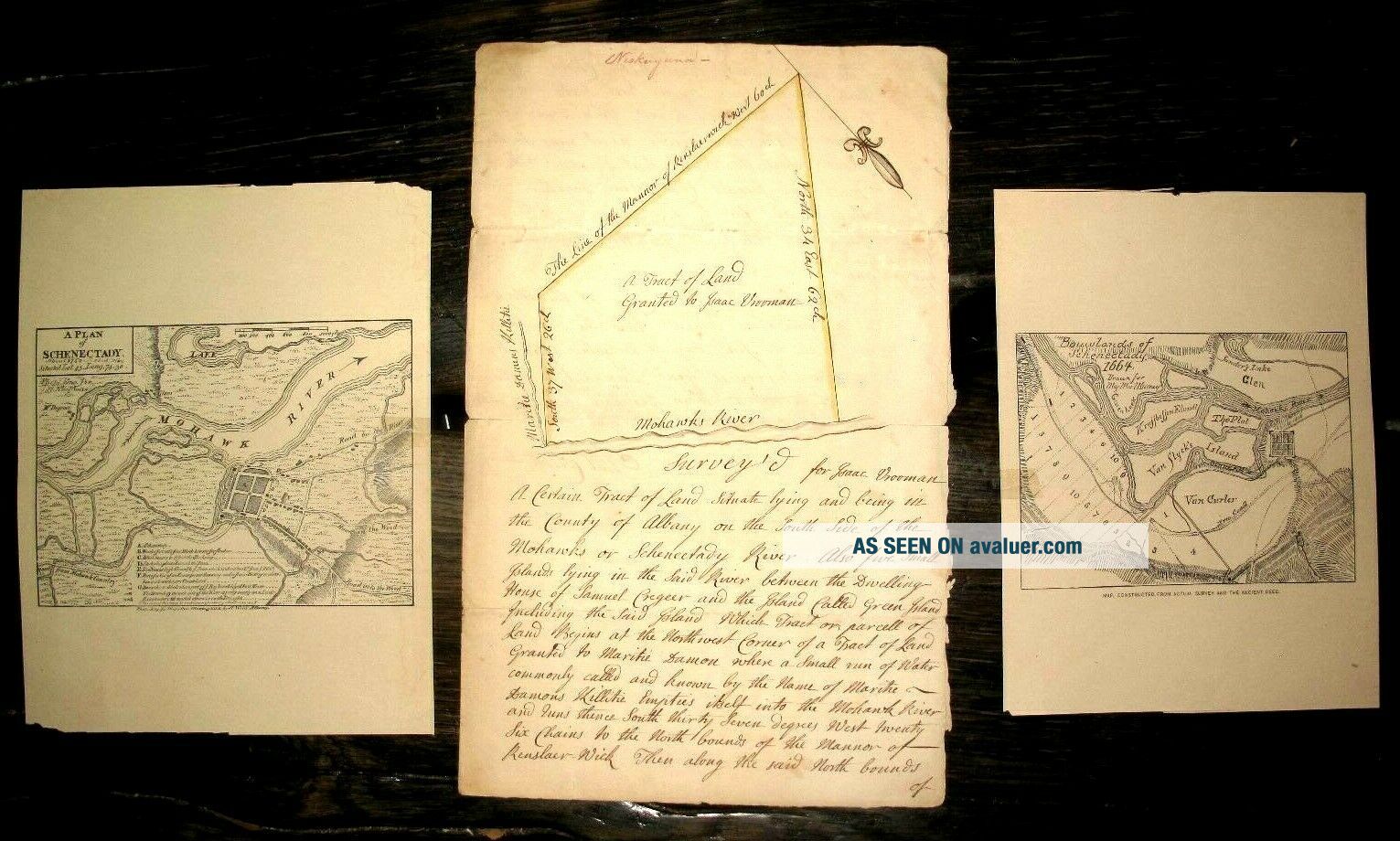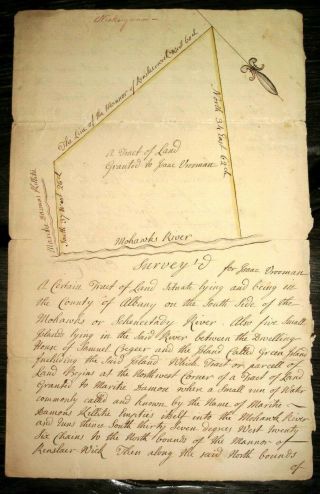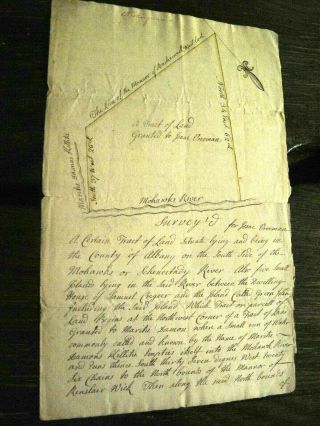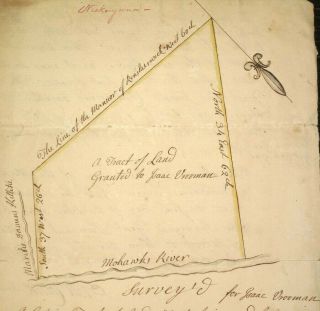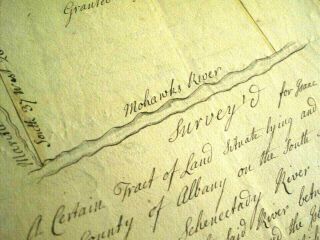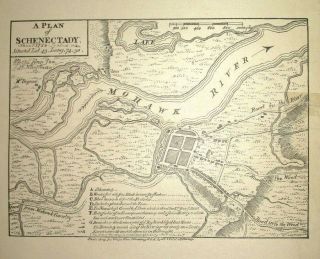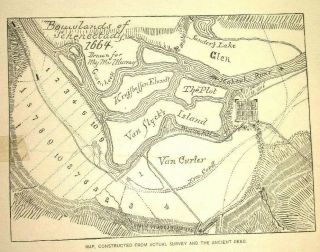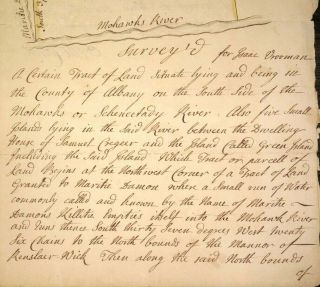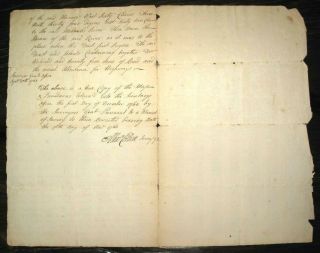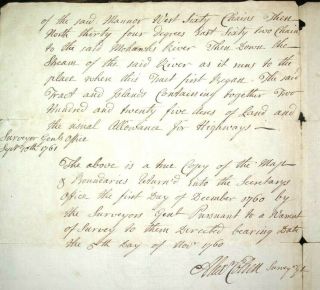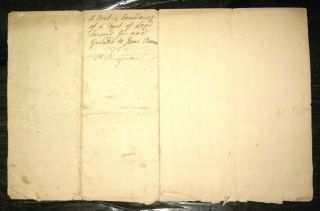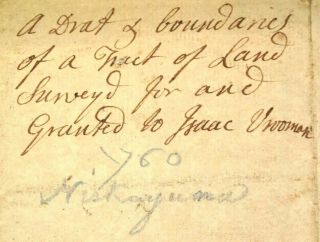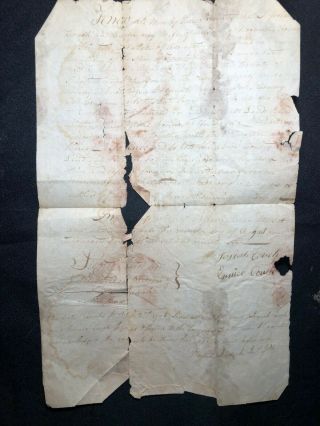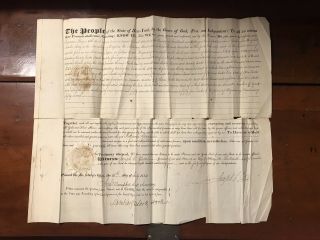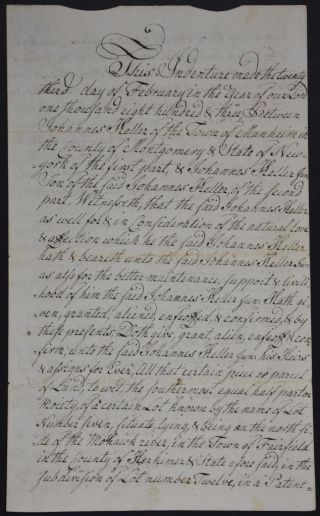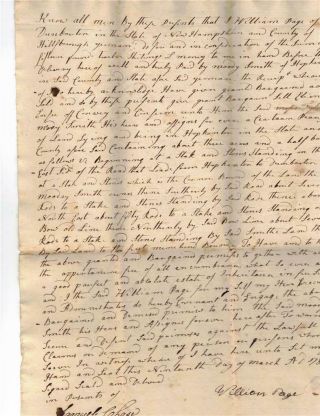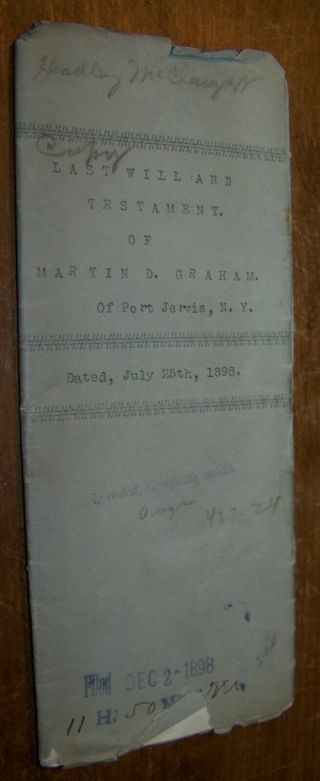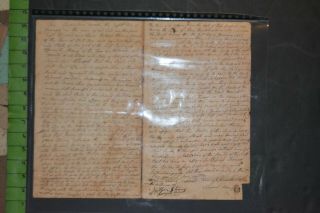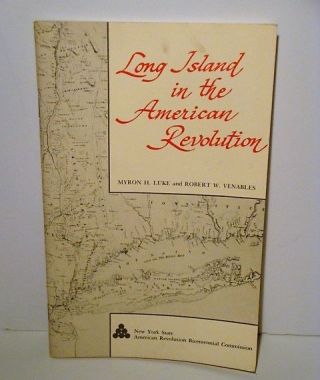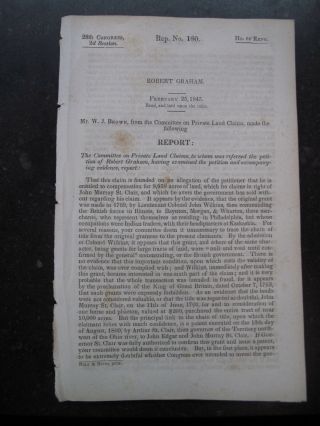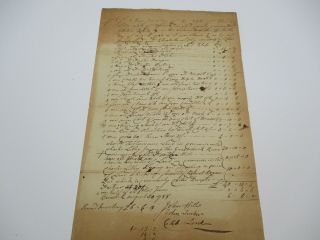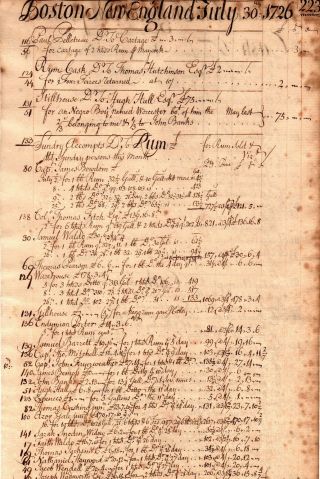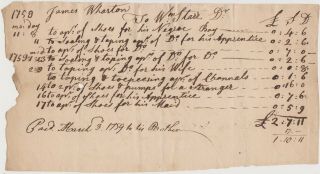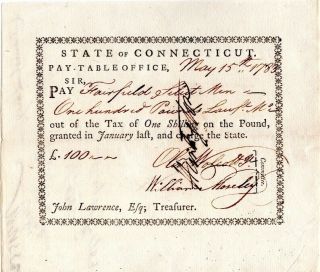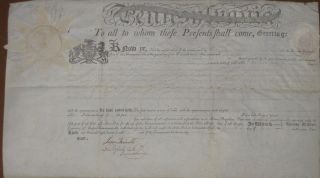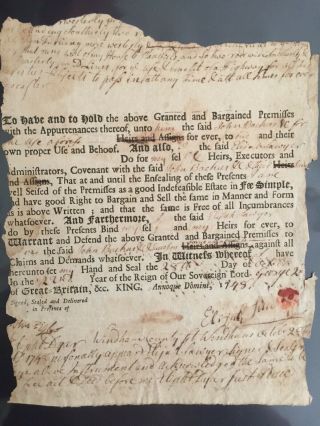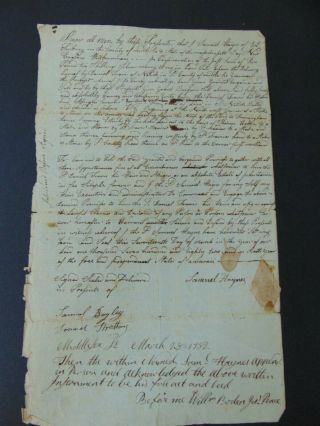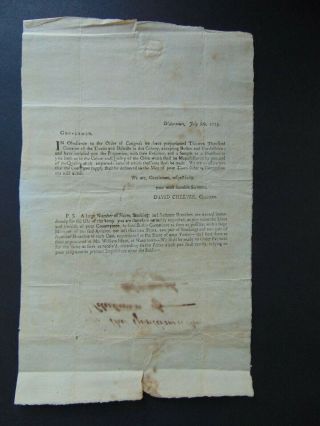1760 LAND DEED Revolutionary War SCHENECTADY NY Vrooman MOHAWK RIVER Survey MAP
Item History & Price
Original and extremely rare early 18th century American deed, penned in 1760- being a land grant for 225 acres of land, including some islands, along the Mohawk River, given to NY Constitutional Assemblyman and Revolutionary War hero Isaac Vrooman! IMOST IMPORTANT IS THE HAND DRAWN SURVEY MAP ...IN COLOR ON THE FRONT PAGE, AS SHOWN!Drawn by Alexander Colden, another prominent New York resident, who was Surveyor General, vestryman at the NY Trinity Church, slaveholder and Postmaster General of NY as well.
More on Vrooman and Colden: Vrooman, Isaac: Born November 13, 1712; died June 1, 1807. He had a farm at the Brandywine Mills in Schenectady NY. On May 7, 1776, he was elected a member of the third Committee of Safety. He was also a member of the fourth Committee and on March 3, 1777, was elected a member of the fifth Committee of Safety. On April 1, 1777, he was elected a supervisor. In 1779 he was a member of Assembly under the first NY State Constitution. During the war he raised two regiments for the Continental Service, and was rewarded by two large land grants from the State, in the patents for which his service is expressly recited.ALEXANDER COLDENAmong the early Colonial settlers the Coldens always held a prominent and authoritative position, and under Cadwallader Colden, the Lieutenant-Governor of the Province of New York and a brother of the Sixth President of Saint Andrew’s Society, the family attained the zenith of its power.Alexander Colden was a son of Dr. Cadwallader Colden and Alice Christy, of Coldenham, Township of Montgomery, Ulster County, New York. He was born in Philadelphia, Pennsylvania, on the 13th August, 1716, and died in the City of Brooklyn, New York, on the 12th December, 1774, being buried in the family vault in Trinity Churchyard.As early as 1727 Dr. Cadwallader Colden took up a residence at Coldenham, bringing with him his family and the then youthful Alexander, and for many years took an active part in public affairs in that locality.Alexander Colden at an early age became interested in commercial pursuits and was appointed Ranger of Ulster County in 1737, which then included Coldenham, where he kept for several years a country store, for the sale of general merchandise. As his business increased in importance he removed to Newburgh in 1743, where he greatly extended his mercantile enterprises and by the use of his name and his father’s official position drew about him many prominent families and settlers. It was due to his influence that the Fowlers, Merrits, Albertsons, and Dentons from Long Island and Westchester County became residents of Newburgh. He was appointed Joint Surveyor General of the Province with his father in 1751, and succeeded him in that office in 1761-1762. In this year (1761) he took up his residence in New York City, where he became a vestryman of Trinity Church, holding the office until his death. He was also Postmaster of New York for some years.Little can be learned of his career in this city except that he made a marked success of all his business ventures, doubtless being aided by his brother’s political affiliations and influence with the British crown.Owing to his support and sympathy with the royal form of government his home was the resort of the best element of the then society, and he gathered around him the highest military and civil officials of the Province.It was perhaps fortunate that he expired just prior to the Revolutionary War, as his family and himself were pronounced royalists, and he would have suffered many indignities at the hands of the American party.Mr. Colden was one of the founders of Saint Andrew’s Society in 1756, and served as an Assistant from 1756-1759; as Vice-President from 1759-1764; and as President from 1764-1766.His will, dated the 24th September, 1773, and proved and recorded in the New York Surrogate’s Office on the 16th December, 1774, throws much light upon his family and the extent of his fortune. In this instrument he calls himself “of Brookland, County of Kings, Province of New York, ” and mentions his wife, Elizabeth Colden, to whom he bequeaths £500 and all his rings, diamonds, jewels, necklaces, watches, his chariot and chariot horses, his single horse chair, his negro wench Florah Nanny, his negro-fellow Dick, and negro children, Mary Ann, Sarah, Phoebe, Elias, Cuckoo, Magdalen, Elias Monkey, and Peter, together with all the use of his plate, pictures, household goods, etc.; he bequeaths to his son John, his negro-fellow Tom, negro-wench Arnot, negro lad Will, and also his gold watch and seal, fowling pieces, pistols, silver-hilted sword, library of books, his presses and cases, his burros or desks, iron chest, clock, reflecting telescope and all his surveying and mathematical instruments, together with the sum of £200, as well as the land purchased from John Talmon and wherein he now resides, and all wagons, carts, plows, etc.; he gives his son, Richard Nichols Colden, certain lands in Newburgh, Ulster County, New York, of which he is in joint possession with Abraham Hasbroek, and further disposes of lands on the Mohawk River, North and South Shore; at Schohary; at Duanesbert; at Cambridge and at Pittstown. He gives to his daughter, Jane, £200, and to his granddaughters, Mary Elizabeth Jane Douglass Hamilton and Alice Margaret Campbell Hamilton, daughters of Archibald Hamilton and Alice his wife, and to his granddaughter, Elizabeth Farrington, daughter of Anthony Farrington and Elizabeth his wife, £100 each. He devises specific portions of his real estate to his grandson, Alexander Colden, son of Richard Nichols Colden and Harriot his wife; to his grandson, Alexander Mark Ker Hamilton, son of Archibald Hamilton and Alice his wife; to his grandson, John CollinsAntill, son of John Antill and Margaret his wife; and to his grandson, Charles Farrington, son of Anthony Farrington and Elizabeth his wife. He further bequeaths to his grandson, Alexander Colden, “my twoeared silver cup known by the name of the ‘Cawdle Cup’ and my silver tobacco box marked with a coronet and the letter R., ” as well as a gold watch, fowling pieces, library of books, etc., at the death of his son John; he mentions his children, Richard Nichols Colden and his wife Harriot; his son-in-law, Archibald Hamilton and his wife Alice; his son-in-law, John Antill and his wife Margaret; his son-in-law, Anthony Farrington and his wife Elizabeth; his daughter Jane; son John; brother Cadwallader and his wife Elizabeth; brother David and his wife Ann; and brothers-in-law, Dr. William Farquhar, the Rev. Samuel Auchmuty, and Dr. Peter Middleton. His wife, Elizabeth Colden, his son, Richard Nichols Colden and his son-in-law, John Antill, are named as executors of the will, and his sons-in-law, Archibald Hamilton and Anthony Farrington, as trustees under the will.His will and the property therein set forth indicates that he was a man of liberal education and much wealth for the period in which he lived.He married Elizabeth Nicholls, the second daughter of Richard Nicholls, Esq., of New York City, and had issue: (1) Richard Nicholls, ensign of the 426 Royal Highlanders; (2) Cadwallader, who died a minor; (3) John, lost at sea; (4) Alice, who married Colonel Archibald Hamilton; (5) Margaret, who married Major John Antill; (6) Elizabeth, who married Captain (later Colonel) Anthony Farrington of the Royal Artillery; (7) Jane, who married Major John Antill, after the death of her sister, his first wife.A vigorous search has been made to locate some portrait of Alexander Colden, but without success. It seems impossible that a man so prominent in Colonial times and so full of the traditions of the English people should not have been painted, but if any picture of him existed it was doubtless carried away to Canada or to England by his daughters and now remains undiscovered among the descendants of the female branches
This early 18th Century American document is a rarely seen commodity on the open market, not to mention with a great hand drawn map, notable persons included, and two later copies of local maps of the areas in and near what is in the deed. Four page document remains in decent shape for age; with some nicks; the second leaf separated at the main fold cleanly from the first. Closed, measures 13.5" x 8.5". Penned in period ink on vellum with beautiful flourished early American penmanship; the ink remains bold and completely legible, and the map has yellow and gray highlights along with a great compass fleur de lis and river illustration. The papers are hand laid and contains a Royal watermark. It is signed by Alexander Colden as shown.
A rare and important piece of New York, Mohawk River and Schenectady/Albany history. Good luck!
MORE ON THE VROOMAN FAMILY
The story of the Vrooman family of early Albany begins with the arrival of Pieter Meese Vrooman who settled in Beverwyck and was among those present at the initial distribution of houselots during the 1650s. He is said to have been one of three brothers who emigrated to New Netherland. Perhaps a brother named Jacob Meese owned a houselot in Albany in 1681. However, Pieter Meese may have been the only Vrooman of his generation to actually live in what became Albany. The family was more prominent in the settlement of Schenectady and its environs. In 1679, the name of "Pieter Meusen" was included on a census of Albany householders.However, none of the first settler Vroomans (Meesens) were represented on the Albany city or Manor censuses taken in 1697 as all three brothers had passed on. The descendants of the brother whose family died in Schenectady in February 1690 were prominent in the rebuilding of that community in the decades that followed. By 1720, nine Vrooman names appeared on a list of freeholders in Schenectady.In 1756, no Vrooman-named residences were included on a census of Albany householders made by the British army. A decade later, no city-based Vrooman households, but at least three in Rensselaerswyck and many more in Schenectady and its environs, were valued on available assessment rolls.In March 1779, no Vrooman-named households appeared on the city assessment roll. At the same time, the list was certified by one Isaac Vrooman.By 1790, no Vrooman-named households were listed on the census for the city of Albany. However, eight family residences were configured in surrounding Watervliet. In 1800, no Vrooman named households were left in the city. The first city directory in 1813 listed only the residence of innkeeper Henry A. Vrooman.After its first generations in Albany and its hinterland, the Vrooman family has spread across the United States where today the name is encountered in many incarnations.



